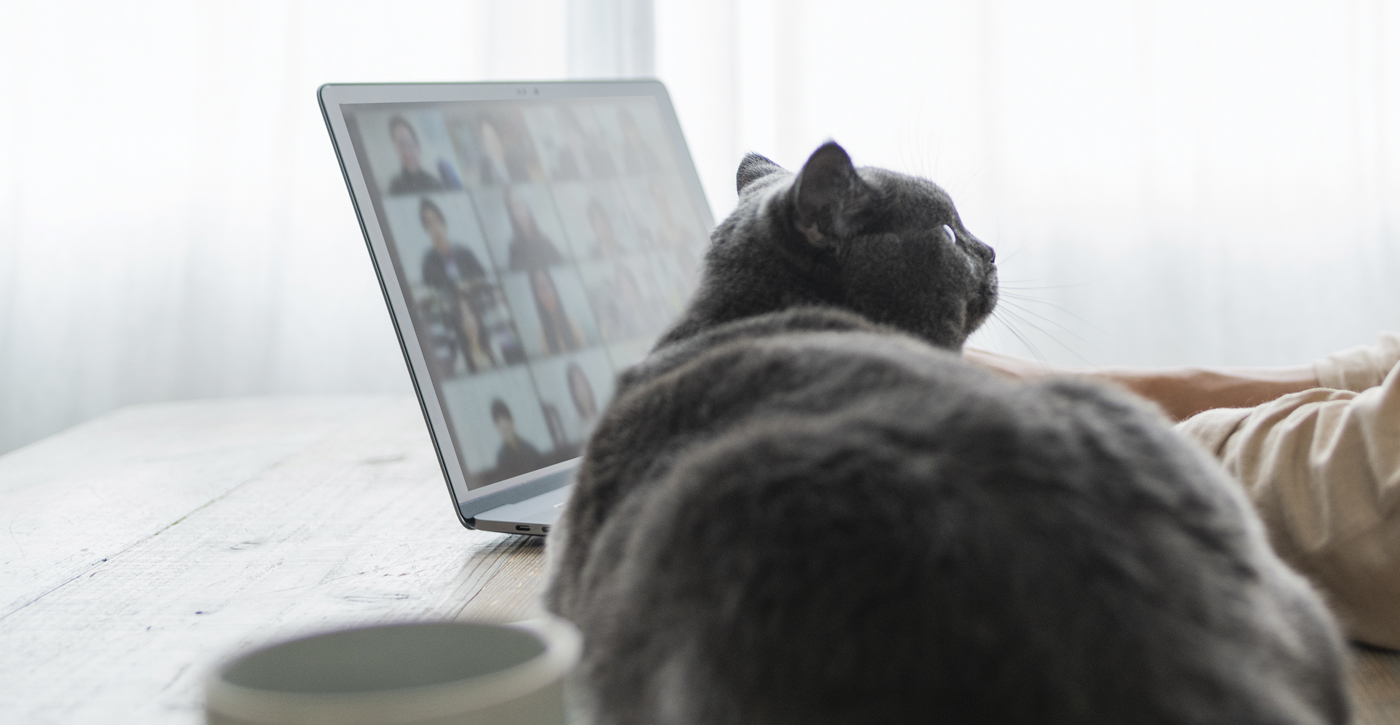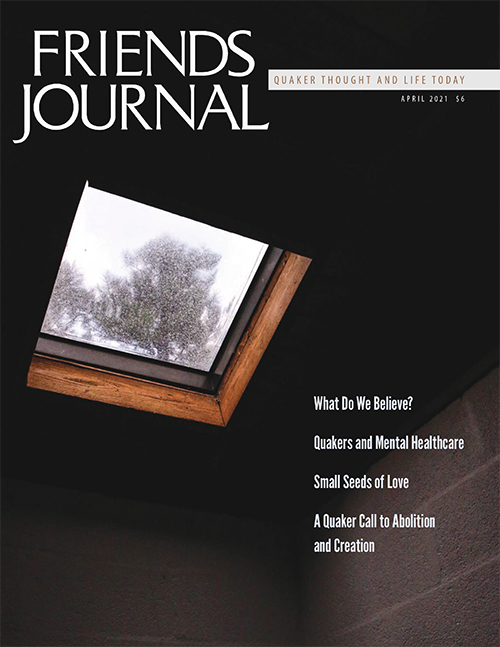Let’s face it: there is something inherently strange (even for Quakers) about sitting with your eyes closed in front of an open laptop computer, its screen filled with images of people you’ve mostly never met. They come in and out of focus when you open your eyes just enough to make sure that they are still there. All of us on this Zoom call are muted so there is no shared ambient noise. This results in an unnatural, slightly disconcerting environment of non-sound. Even the “we”-ness of this online gathering is unstable, since any given sneaked peek may reveal a new participant, who has likely changed the pattern of rectangles on the screen. To top it off, the people participating are all “here”—virtually—because we’re hoping that a spiritually satisfying (but highly intangible) experience will result.
So the question is, does it?
And the answer—oddly, surprisingly, even miraculously—is that it does. Or at least that it has, steadily, for a small group of Quakers that has been Zooming since last March, logging hundreds of days of daily worship. Whether this experience is applicable to others or replicable, I can’t say, but I believe it’s a story worth telling, remembering, and filing away for the future.
It all began in mid-March, just days after the World Health Organization declared COVID-19 a pandemic, when the Ministry and Counsel Committee of Allen’s Neck Meeting in southeastern Massachusetts made plans for its first Sunday service on Zoom. Peter Crysdale made an impromptu offer to host half-hour Zoom worship sessions for the other six days of the week. Peter served as the minister of Allen’s Neck from 2002 to 2011 and has had several other less-defined roles over the ensuing years (he now refers to himself as “Minister Among Ministers Emeritus”). Quickly reaching out to local Friends at Westport, Sandwich, and Falmouth Meetings, he also contacted individuals further afield who might be interested (myself among them, happily), including members of the writing group he’s run for years. Peter later recounted:
I was struggling with my role within the meeting, and this came as an opportunity to do something I loved. At the beginning of the pandemic, I remembered attending daily worship at Pendle Hill [study center in Wallingford, Pennsylvania] during the ten years I was there and how after several of those years that half-hour meeting in the Barn had gradually grown into a profound realization of what silent worship was, and that it was essential to my life. So I wanted to offer that, though I didn’t really think it would take, or that it would last.
Peter added:
I also came to this experience with a slight disdain for Zoom. I didn’t think the technology could work as a meetinghouse. But I immediately felt a connection with the people who showed up and had no ambivalence about silence. It’s lovely to jump in the deep end with people, where you have no idea what’s going to happen, and we soon found that the worship we entered into was real and really quite deep. The with-each-otherness that’s developed has surprised us all.
This sense of surprise is echoed regularly in the messages from daily meetings. As one person observed recently:
This rhythm, this expectation that I will have this time with you all—and with God—this idea of practice and going deeper is just amazing. The connection that I feel with you over Zoom, how does it happen? I only see a little of you and your homes, but we have created such deep intimacy.
Even an attender who regularly joins the group by phone, which would seem to lessen the connection, has shared her sense that “something magical is happening here in this medium that I didn’t think possible. It’s become one of the firmer practices in my life during a time when everything else is pretty upside down.”
Others appreciate their experience of worship for its sense of continuity. As an original member of the group reminded us, “The history of Quaker worship began with regular ‘family worship’ at home, so I consider what we’re doing to be historically based. And that fills me up—we’re doing what we used to do.” To which another Friend added, “This sitting in daily worship is something I have long wanted. It was hoped for, yet I had not the wherewithal, alone, to mold my time. But together—the six or eight or twelve of us—we have become the heart of my daily practice.”
“We don’t do introductions, and we don’t do announcements,” Peter explains. “That might sound strange, but I think it gives people a sense of singleness of purpose. It reminds me of the old advertisement for Tetley: ‘The tea that dares to be known by good taste alone.’ In other words, it’s all about the silent time.” In direct confirmation, a long-term attender noted, “This has been a very safe environment for me, maybe especially because it doesn’t involve any business; it’s been pure worship.”

Photo by Rymden
For the first eight months Peter emailed a Zoom invitation for the 8:30-to-9:00 a.m. session to a couple dozen people every Monday through Saturday. The participants were, and remain, heavily weighted toward retirement age and largely from New England. But it’s the exceptions to these characteristics—the people considered to be most “from away”—that give our community stone soup some of its liveliest seasoning. For example, we are lit up any time the young family from Harlem in New York City is able to join us (usually during breakfast), when both mom and toddler are likely to share. And the “weighty” couple from the United Kingdom, originally connected through Peter’s writing group, always broaden and deepen our perspective.
As it turns out, our animals are the garnish. The cats on the windowsills and furniture or on laps where we can’t see but still feel them: the orange tabby tail that twitches and curls in front of the camera from question mark to exclamation and back again. One small dog hops with aplomb on and off a settled lap, while my three cows—too large for an indoor presence—are nonetheless included in our shared creaturehood. Without question, we smile more because of them.
And where, it’s fair to ask, does smiling lead to but the warming of our hearts? We feel it daily despite not having met. For all of our Yankee-ness, declarations of affection flow freely among us. On one particularly trying day (was it a heavy downpour or just the growing seasonal darkness?), a simple message spoke the minds of many: “I love you all. I needed to be here. You are my rock.”
“This rhythm, this expectation that I will have this time with you all—and with God—this idea of practice and going deeper is just amazing. The connection that I feel with you over Zoom, how does it happen? I only see a little of you and your homes, but we have created such deep intimacy.”
Around such experiences—and such expressions—concentric circles continue to form. Inner tenderness deepens the relationships we have with others in our lives, and with ourselves. As a parent explained shortly before the holidays, “I had been approaching my children with anxiety because they were so far away, but now I’m deepening my relationship with them because I’m coming to them more softly, with more of my heart open. That’s a clear benefit of faith.”
Late in the fall, after friends of Friends began expressing interest in joining the group, Peter presented the idea of adding a second worship session. After some discussion, we agreed to an experimental additional half-hour for the month of December, to run from 7:50 to 8:20 a.m., with a ten-minute break before the next meeting. It was an arrangement that delighted Peter from the beginning since, as he loves to announce, it makes us “the only Quaker meeting that has a halftime.” He has recently taken to adding, “And sometimes, when our meeting is deep in worship, we also go into overtime.”
Interestingly enough, the additional daily meeting did not result in the flood of new members that some had feared. Instead, the people already attending began to do their own experiments with the new schedule: some migrated to the earlier time slot; some stayed with the later one; and many continued to move back and forth as it suited. A few stalwarts—even some who had previously announced that an hour of silence was “way too long”—now sit through both sessions, sometimes including the extra ten minutes in between. With solid group approval, the two sessions are still going strong.
Over the course of the year, a core group of people tend to show up most days and a nearly equal number of individuals show up irregularly—when they can or as they’re “called.” They are never made to feel they are lesser members; I tend to think their comings and goings help keep things interesting and dynamic. It is also not unusual for people to leave early or show up late without any kind of censure. The message that we are all welcome and that there’s always a place for us at the table—which can sometimes be mere assertion—feels embodied here. It feels physically and psychically true.

Photo by Andrea Piacquadio on Pexels
The community that results from all this seems to have greater capacity for fluidity and permeability, qualities that make for healthy organisms. “Gathering in worship with folks some mornings, and knowing they are there even when I’m not Zooming in, has pulled me into Spirit much more than I imagined it could,” explained an occasional participant. “I love that I can arrive and immediately enter in.” Another reported that she’s even “had the experience that I could feel the prayers of folks far distant.” She also has noticed herself giving active encouragement to those who bring messages—a role she’s currently exploring—which she deeply appreciates.
Gratitude, in fact, is our most frequent theme, and “I am so grateful for this community” or “The gratitude that I feel in worship sets my tone for the day” are common expressions that are heard often. One Friend enumerated the blessings in her personal journey:
The development of the Quaker morning worship has held me spiritually through this extraordinarily challenging time in a way that nothing else could. I grew in ways that I had never yet experienced. I grew together, if that makes any sense. I grew—it was a journey all to myself—but I grew in the community, love, support, and neutral spirituality of the Zoom worship . . . which came right on time. In God’s time, as they say. I am so grateful.
For Peter, a focus on silent worship itself is part of his figurative and literal ministry. Allen’s Neck Meeting, under his guidance, has been moving over the past 10 or 15 years from a programmed group with a worship script to an unprogrammed format without a script. As a result, he notes, “We have very few ‘seasoned’ Friends in our meeting. It’s difficult to learn an experience-based faith from a syllabus, so this learning how to be Quaker is a high priority for me.”
As if in response to Peter’s concern, one of the newer members of Allen’s Neck recently examined some insights he’s been receiving from the daily Zoom worships:
As I am someone who likes to be in control, this surrendering and giving up and learning to listen better has not been easy. In fact, it continues to be a real challenge. But after having participated in this practice since last spring, I feel that I am on the cusp of grasping the idea of “entering the stream,” and I look forward to being able to partake and accept more fully as we continue on.
We are, all of us, working hard. A regular attender explained how a commitment to daily worship has helped strengthen her faith:
I joined the daily Zoom worship group at a time when I noticed I was responding to the COVID situation by getting irritable. I also realized that COVID, police violence, and climate change were demonstrating to me that I had really, all along, been putting my faith in human strength and cleverness rather than in God. So a daily worship was attractive as a way of growing a stronger faith in God and settling into a daily practice that would also help me deal with short-tempered people. It has done that. Messages from the Spirit and from Friends during worship are helping me understand how to live in faith, one little nudge after another.
Worship, prayer, faith: they are all being addressed. “I am thinking today about the experience of expectant waiting,” someone shares near the end of the half hour, “which took many years for me to understand. For a long time, it was a place where I just waited for a message, but at some point in my faith practice, I came to see that sweet longing of expectant waiting as something in itself.” The speaker begins to smile (and—wait—is her rectangle starting to glow, just ever so slightly?): “It was like a warm bath for my whole spirit, and I really enjoy when I can get there—I love being there.”
Day after day, we seek clarity. This comment from a Friend who thinks deeply and speaks only infrequently illustrates our group’s evolution over time:
I look at us and see two ideas: The first is the idea of worshiping daily as obedience—something we commit to—which has an effect on us; for me, it’s like it has created a well-lit path to the center. Obviously, I stray off it at times, but it’s a blessing. The second is that this group has come together, and we have opened ourselves up to each other. We have become a meeting: we are a meeting; this is what we are.
The community that results from all this seems to have greater capacity for fluidity and permeability, qualities that make for healthy organisms.
Nudged, bathed, surrendered, we continue our practice, one gathering at a time. These days, however, with vaccinations a reality for a growing number of people and a new president duly inaugurated, a better future is coming into focus. How these changes will affect us and reshape the experience we’ve been having is not something we have begun to consider. Even Peter, the “mad scientist” who created us, seems satisfied that we are proof that “a small group of attenders can be drawn slowly into the sense-experience of what Friends worship is” without looking beyond.
There will be more to our story going forward, but instead of attempting to guess what comes next, I’m trying to lean into the wisdom of “it will be known.” What is true for now is that some constellation of a “we” will continue to show up each day to sit in front of our silent screens—our Quaker quilt—no longer strangers but still techno-gathering and still expectantly awaiting our small spiritual miracles.




Comments on Friendsjournal.org may be used in the Forum of the print magazine and may be edited for length and clarity.